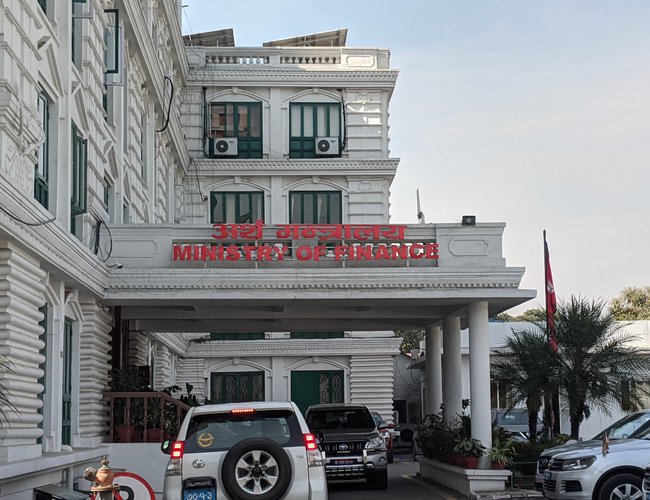
The government has introduced a budget replacement bill in the parliament amid opposition slogans in the last week of September. In the introduced bill, the government has slightly reduced the size of the budget. However, there has been widespread criticism and discussion that the election-focused distribution-oriented program has been added. Amending the budget of Rs. 1.647 trillion brought by the former finance minister through an ordinance for 2078/79, the current finance minister has presented a revised budget of Rs. 1. 632 trillion . This shows that the government at that time was a little excited to increase the size of the budget. Thus, when a budget is announced without resources, aspirations will increase but will not be fulfilled.
The past three budgets, presented by about two-thirds of the government, have seen a significant shift in target numbers in terms of both resource mobilization and expenditure. The biggest hit was on capital expenditure. There is no scope to reduce general expenses. When capital expenditure is cut, development programs shrink.
The current budget cut of Rs 15 billion is also towards development. Some private sectors have also welcomed the introduction of a bill to replace the current fiscal year's budget with a policy to transform the economy based on imports and remittances into domestic production and internal income-oriented economy.
The government has announced to reduce trade deficit by conserving indigenous products, identifying exportable and comparatively advantageous goods and increasing competitiveness. In the past, those in government have been criticized for spending the budget on distribution-oriented and unproductive sectors while in opposition. Even this budget has not been able to give up the greed for distribution. For example, budget obligations that distribute cash are added.
The budget stated that Rs. 3,000 per month would be provided for the families who sacrificed in the movement for political change, and Provision will be made, the amount will be transferred from the local level by mid-October, and it is mentioned that soft and accessible food will be provided to the urban poor in at least 10 places in the Kathmandu Valley in collaboration with social organizations.
It is also mentioned that the kidney transplant patients, all types of cancer patients and patients with spinal paralysis will be provided medical treatment. Even if there is immediate relief from this, it will add more burden in the long run.
There is a program to provide unsecured loans to 500 people at each local level. Some people say that some of the issues in the replacement bill are populist. The budget does not seem to address the government's minimum common program and white paper.
The Finance Minister has insisted that the budget replacement bill had to be brought because of the main opposition party CPN-UML. Regarding the replacement bill, the Finance Minister said that the bill had to be passed in three days due to the opposition UML.
It is said that the revenue target has been increased by reducing the budget a bit, the nominal schemes have been scrapped and the projects that will not benefit the people and will not benefit the state have been postponed.
The capital allocation was increased by reducing the debt target. It has been made public that the action plan will be made on the assumption that every plan should pay off and the budget has been prepared to build the economy as specified in the constitution.
The finance minister has claimed that the budget he brought through the replacement bill is not distribution-oriented. He said that the budget was not distribution oriented but it was trying to fulfill the responsibility of the state. Ordinance in the budget .
Regarding the increase in the economic growth rate of 6.5 to the current year in the replacement bill by more than 7 percent, the Finance Minister said that the basis for keeping the economic growth rate of 7 percent in the replacement budget is the availability of covid vaccine.
Among the important points of the explanation given by the Finance Minister: In order to fulfill the responsibility of the state, budget distribution in some areas, restructuring of the budget to maintain financial discipline, the government is issuing new types of bonds to mobilize investment resources in the infrastructure sector. The policy is to encourage the private sector to build and operate infrastructure such as expressways, tunnels, expressways and flyovers.
Similarly, the government has expanded the scope of agricultural crop and livestock insurance to increase the attraction of farmers in the agricultural sector by reducing the risk in agriculture and livestock business by increasing the insurance premium subsidy from 50 percent to 80 percent. Informing that the government will formulate a policy and mechanism for monitoring the cooperatives through the current year's budget, the budget has also taken a policy that the cooperatives should invest 50 percent of their loan investment in agriculture and productive sector by setting up sister companies.
Arrangements have been made to set up small processing centers linking agriculture with industry, providing various concessional facilities and concessional loans for setting up small, medium and large scale industries and other industries based on indigenous raw materials.
Similarly, the government has expanded the interest subsidy program for small and medium enterprises, commercial agriculture, youth enterprises, women enterprises, returnees from foreign employment, Dalit community business development loan and other concessional loans for self-employment.
The budget has also put forward a policy to protect the interests of general investors by maintaining good financial governance in the capital market. Provision has been made to enable the potential public enterprises under the government to become self-reliant and mobilize additional sources of investment by listing them in the capital market by transforming them into fully government-owned company models as required.
The government has taken the policy of operating, scrapping or managing the public enterprises which have been running at a loss through structural and managerial reforms through the current year's budget. The government plays an important role in formulating and implementing economic policies and programs for economic growth as well as rapid development of the economy.
In the case of Nepal too, the economy has not been able to pick up the expected pace due to unsatisfactory implementation of policies and programs for policy reform at various times. Tax rates are high in Nepal. Higher tax rates do not boost industry and consumer prices. It cannot increase investment. In order to increase the revenue by expanding the scope of investment, the tax rate should be kept low.
Looking at the budget, the tax on two-wheelers above 125 cc has been increased. Mention that a high level commission will be formed to reform the tax system.
To levy advance tax at the rate of one percent for providing electronic services or uploading audio-visual content on social media. The 200-megawatt hydropower project will provide 50 percent income tax exemption for the entire 15 years after the start of business and for the next six years. 50 percent tax exemption for the year, exemption in excise duty on domestically produced motorcycles, increase in risk tax on tobacco cigarettes, exemption in VAT on electricity distribution and transmission etc. are prominent.
The Finance Minister has said that the tax on motorcycles has been increased to increase the use of electric vehicles. He stressed on the argument of increasing the tax on motorcycles to implement the government's policy of increasing the number of electric vehicles in the country and also making public vehicles electric.
It is said that the increase in tax on more CC motorcycles is an incentive for electric vehicles. At the same time, the bill, which aims to reduce multidimensional poverty, revitalize the economy, boost economic growth and build an inclusive and socialist-oriented economy, is expected to keep the economy afloat. The interest subsidy program has been expanded to provide small and medium enterprises, commercial agriculture, youth enterprises, women enterprises, returnees from foreign employment, Dalit community business development loans and other concessional loans for self-employment.
In addition, the announcement of adoption of Engineering, Procurement, Construction, Investment (EPCF) method to make public-private partnership more effective in infrastructure development will attract the private sector to large infrastructure. The money saved by deducting current expenses should be used to purchase vaccines against Covid 19.
- Do Not Talk Too Much Negatively About Nepal!-Success Or Failure Of Nepal: Is It An Economic Problem? -
- Jun 23, 2024
- A Lot Of Heat Day In Nepal!!! Or Has The Summer Temperature Broken The Record So Far?
- Jun 03, 2024
- Nepal's 2081/82 Policy and Programme, Parliament Obstacles:Some Perspectives
- May 16, 2024
- Impact Of Indian Elections In Nepal
- May 03, 2024
- A Review Of The Handwritten “Gita Saar” Written By Krishna Prasad Lacoul In 1967-68 B.S.
- Apr 19, 2024

















